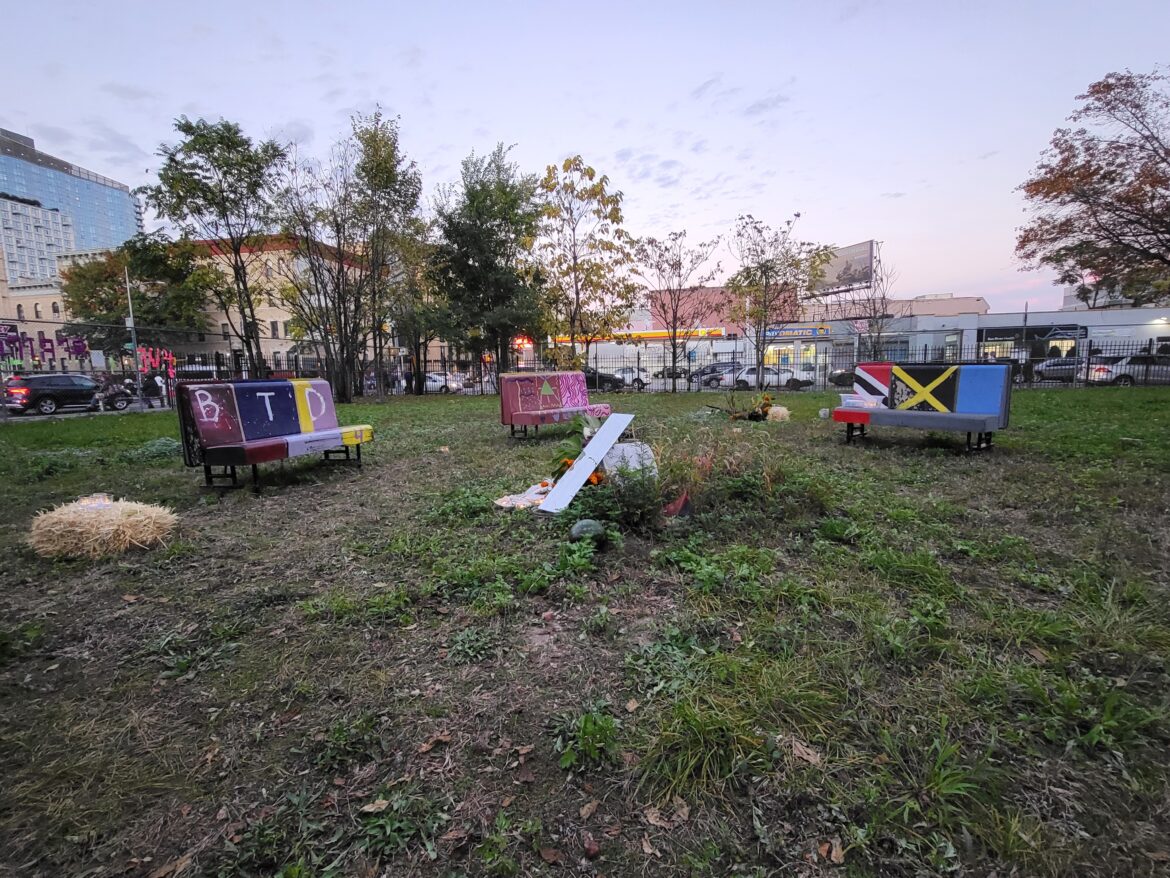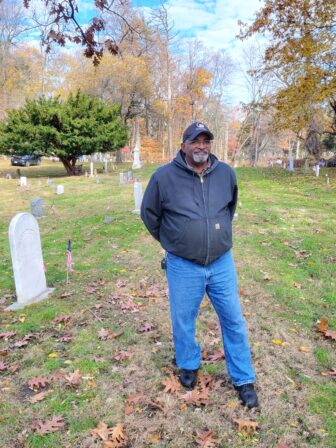“My concerns are that if these storms keep getting worse, ancestral remains might come to the top,” said Shantell Jones, secretary of the Flatbush African Burial Ground (FABG) Coalition.

Marina Dunbar
The Flatbush African Burial Ground on Oct. 27, 2023.On the eighth of a nine-night funerary celebration, a circle of about 20 people sat in solidarity to celebrate Pan-Africanism and honor their ancestors. It was unusually warm for a late October evening in Brooklyn. The 72 degrees Fahrenheit weather might be convenient for an outdoor ceremony, but on this night in the Flatbush African Burial Ground, it served as a reminder of a brewing battle.
The rugged earth beneath—which houses the remains of enslaved Africans who lived and died two centuries ago—was spongy and moist from extreme flooding that had unexpectedly hit New York City three weeks earlier, shutting down subway lines and leaving some neighborhoods like this one underwater. As Panamanian musicians sang in their mother tongue, dancing attendees took care to avoid the ground’s uneven dips and muddy puddles.
The theme of the night’s ceremony was the African diaspora, and as a microphone passed around the circle, attendees shared their ancestral history: Moroccan, Nigerian, South African, Irish, Ghanaian, Native American, Trinidadian. A musician shared his experiences with racial discrimination and feeling isolated from his African roots. As another speaker discussed being a descendant of slaves, and how so many ancestors drowned before reaching America, attendees swatted away mosquitoes nesting near the still flood water.
This burial ground is a sacred place for people to collectively honor African ancestors who were subjected to slavery. But now it faces a new threat: climate change.
“My concerns are that if these storms keep getting worse, ancestral remains might come to the top,” said Shantell Jones, secretary of the Flatbush African Burial Ground (FABG) Coalition, which has spearheaded efforts to track down remains that were removed from the site due to development.
“I don’t know what the city would do if that happened,” said Jones. “We’re already on a mission to recover the remains that were already taken from here, and now we have this other worry of more resurfacing and potentially getting destroyed or washed away.”
These concerns aren’t unique to New York: cemeteries in the Southern U.S. have been ravaged by climate change, with Black resting places at particular risk. Historical racist practices such as redlining and lack of funding for Black communities has forced cemeteries into higher-risk areas.
Being located close to water can put grave sites in greater peril. The wetter the land, the more unstable the burial plot. Rising sea levels are an ever-present threat, but increasingly frequent storms and downpours are another menace to those trying to protect their resting ancestors.
In 2022, Green-Wood Cemetery in Brooklyn embarked on a $2 million resiliency project to curb flooding. In certain places in the South, special task forces have been created to help repair and prevent cemetery damage, such as one in Baton Rouge.
“There needs to be infrastructure changes in New York to handle storms and water drainage,” said Shanna Sabio, co-founder of GrowHouse NY and a trustee for the FABG Coalition. “The burial ground holds so much water, so it doesn’t have adequate drainage. There are dips and valleys, the ground is so uneven. Mosquitoes then breed in there. There’s so much that happens just from excess water.”
But excess water is far from the only consequence of global warming on burial grounds. In some cases, the climate veers to the other extreme, with droughts causing the earth to dry out and crack, potentially exposing remains. Unpredictable weather conditions can also lead to severe wind, which serves as its own threat to cemeteries.
In Rye, New York, a Veterans’ Day celebration is held annually in the historic African American cemetery on the Saturday after the holiday. This past November, a small circle of about 15 locals stood together to share the importance of preserving African American history. They held small American flags as they discussed their own connections to slavery and war.

Marina Dunbar
The African American cemetery in Rye, New York, in November. The adjacent Beaver Swamp Brook is in the foreground.There are 22 known veterans of the Civil War, Spanish American War, World War I and World War II buried in Rye’s African American cemetery. Many of these gravestones are hundreds of years old. Some are unmarked.
The cemetery is located right next to Beaver Swamp Brook. David Thomas, a historian and president of Friends of the African American Cemetery in Rye, said he considers it a “miracle” that flooding hasn’t affected the cemetery so far. There is currently no plan in place to deal with the threat of rising waters, he said.
“The worst damage comes from fallen trees,” said Thomas. “The limbs have come down and actually knocked over headstones… We consider ourselves lucky that that’s the worst that’s happened.”
For the past 12 years, Thomas has led the effort to restore and continuously care for the cemetery after it fell into a state of disrepair. Robinette Robinson, an 86-year-old retired administrator in Mamaroneck, is perhaps the most grateful for his efforts.
“The first time I visited the cemetery was when I was 12 years old on Memorial Day,” said Robinson. “I remember being so frightened when I went there because I had never seen any place that looked like that. The weeds were up to my chest.”
Robinson would later discover that she had family members buried in the cemetery, including her great-great grandfather, Robert Purdy, who escaped slavery and now rests on the southern side of the site.
“We [African Americans] are not supposed to have a history,” said Robinson. “We’ve been brainwashed into thinking our history is just one of servitude and not of accomplishment. I grew up not knowing my family history and I can say the same for all my friends. That’s what having this cemetery means to us, it’s a connection to our heritage that we never got to have before.”

Marina Dunbar
David Thomas, president of Friends of the African American Cemetery in Rye, said he considers it a “miracle” flooding hasn’t affected the cemetery yet.There is a long history of these cemeteries having to fight for the right to exist. Flatbush District No. 1 School (later Public School 90) was a city-designated landmark that stood on a portion of the Flatbush African Burial Ground until its demolition in 2015 due to structural issues. Since then, there has been an ongoing battle to protect the burial ground from further development.
Most early maps of Flatbush did not acknowledge the burial site’s existence, and physical evidence of the cemetery was affirmed only after archaeological testing in 2001 because of planned renovations by the School Construction Authority to the former school on site.
The Flatbush Burial Ground is under the stewardship of the New York City Department of Parks and Recreation. A representative from the department told City Limits, “Parks is committed to thoroughly engaging the community, in partnership with Council Member Joseph, to discuss their wishes for the burial ground. As with all of the spaces we manage throughout the city, ensuring the resilience of the burial ground will be a major component of our work.”
According to experts in cemetery preservation, ground-penetrating radar is one of the most useful tools for protecting burial grounds, particularly for recognizing those in presently unmarked graves. The technology allows advocates to track how many remains are buried and where exactly they are located without disturbing their rest. This way, if the cemeteries were to become flooded and remains scattered, they can be returned to their rightful resting place.
Jenny Wolfe is an archaeologist who has worked as the historic preservation officer for the nation’s oldest city in St. Augustine, Florida. She has been responsible for directing research for climate change initiatives such as disaster mitigation and sea level rise in the state, and says that unmarked burials are often the most vulnerable to being lost. And if a new burial site is discovered, such as what happened in Flatbush in 2001, it’s up to the local government to make sure they can be swiftly designated.
“The most important first step is documentation,” said Wolfe. “Making sure that, number one, you document the cemeteries that you know of, and secondly, to have a process in place so that if you do have an unanticipated discovery, like you run into a burial in the middle of the street or a building foundation, that you can be prepared for that.”
Ryan M. Seidmann, chairman of the Cemetery Repair Taskforce in Baton Rouge, agrees that documentation is key to preparing for disaster. “Map everything, even the small family cemeteries,” he said. “The documentation can be as simple as photographs. Just take a lot of pictures and keep them in a central location that can be accessed after something hits… It’s a good idea to write names on the caskets too. Anything that will help you identify someone.”
The Town of Rye began the process of using radar to map the historic African American Cemetery on Oct. 30. The FABG Coalition says it is currently writing grants to obtain funding in order to begin using ground-penetrating radar.
“We’re uplifting their name and we’re giving them visibility,” said Jones. “This is the least that we can do. They weren’t allowed to speak up when they were here, and they can’t do it now. So, we’re doing all that we can to speak up for them.”
To reach the editor, email Jeanmarie@citylimits.org








